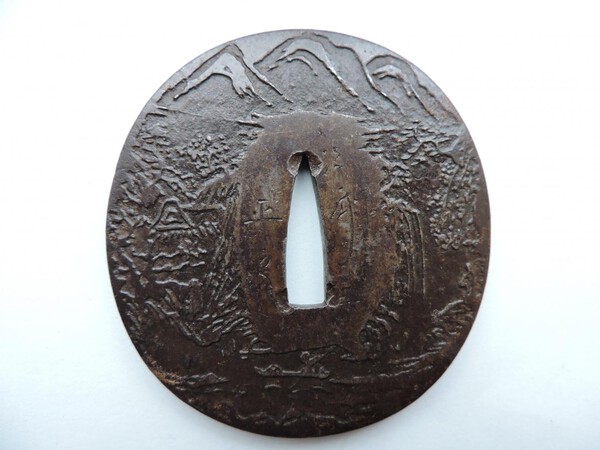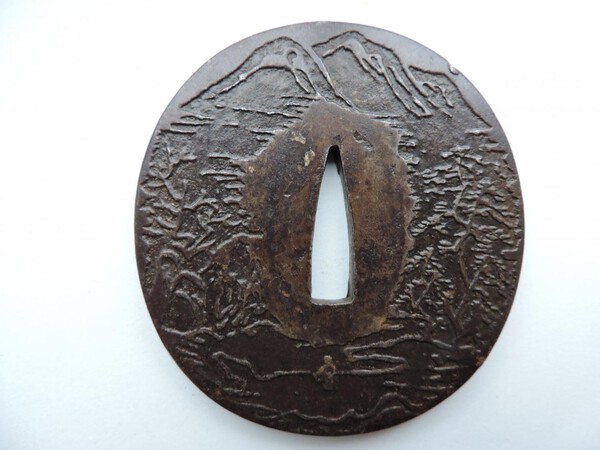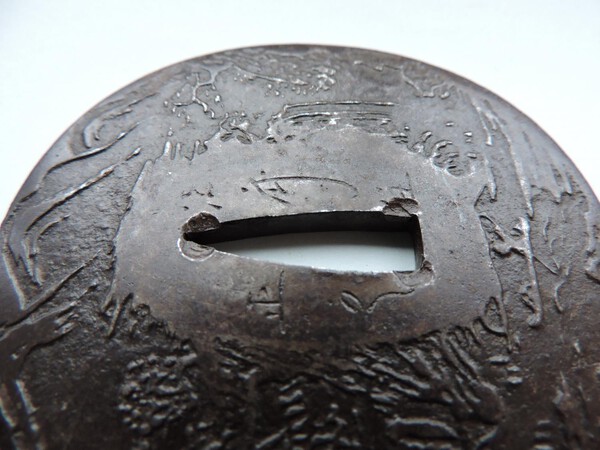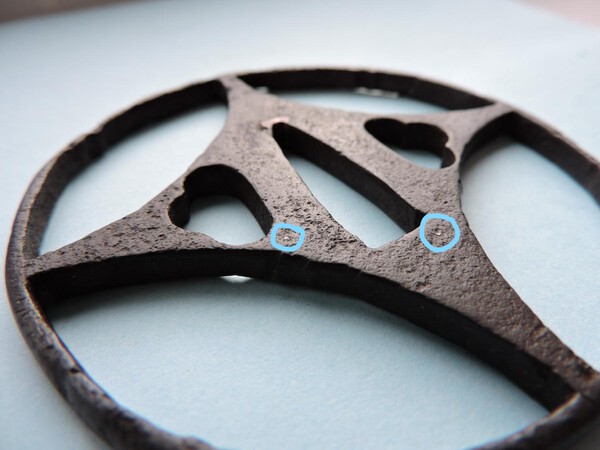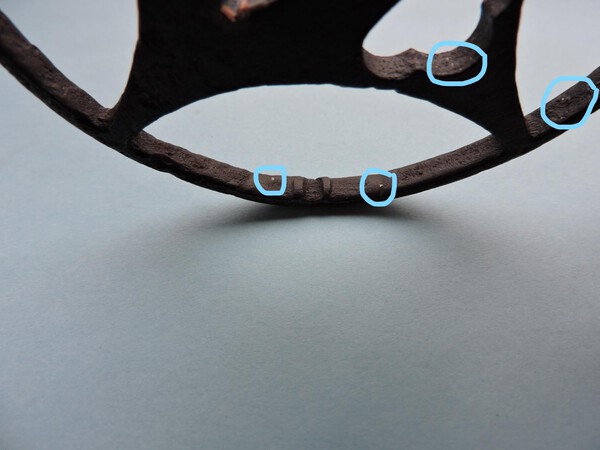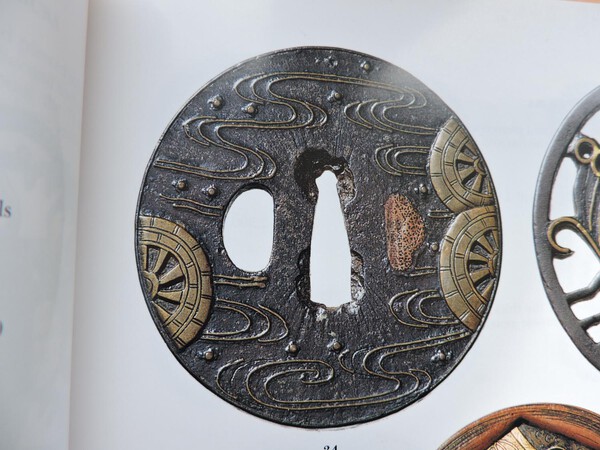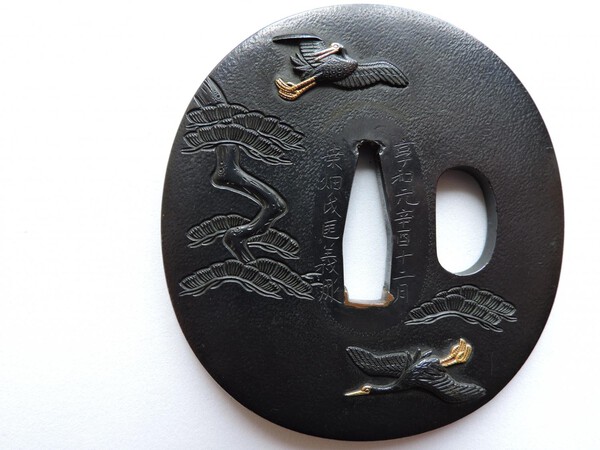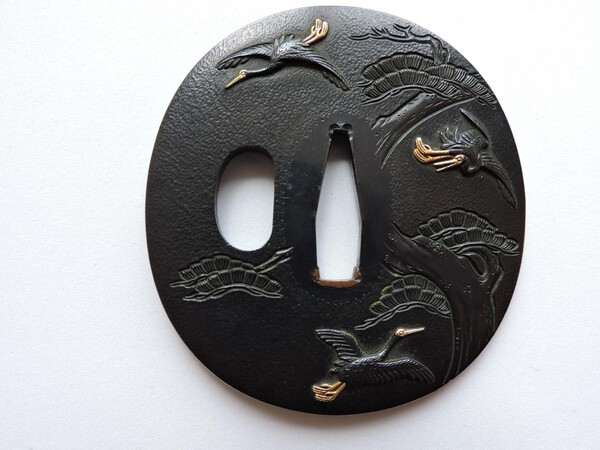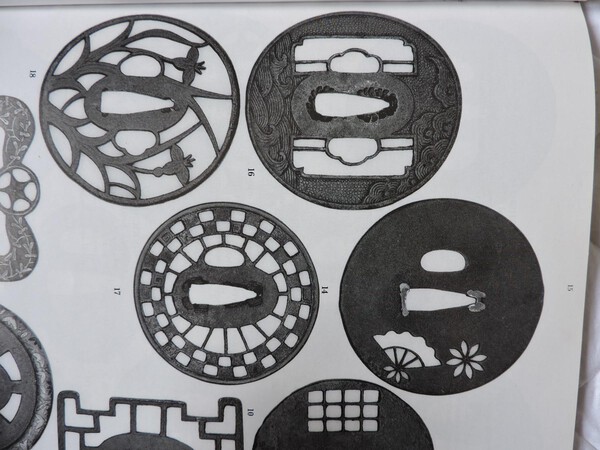
JohnTo
Members-
Posts
268 -
Joined
-
Last visited
Everything posted by JohnTo
-
Hi Jeremiah, A very nice restrained design. One adverse observation is that the surface either side of the nagako ana looks like it has been hammered flat. If it was not for the NBTHK Hozon I would be wondering if someone had not obliterated a signature that they did not like. Any explanation? all the best, John
-
Thanks guys for your comments. It seems that there are some nice Tochibata tsuba out there that are not cast, despite the Nihon To Koza virtually describing the Tochibata School as a minor one of village blacksmiths. I see that the Ebay tsuba sold for about £90, so maybe someone got a bargain in terms of a rust free sukashi tsuba from a rare school, or maybe not. I’m still left with the question as to who/why someone should want to make cast copies of a little known school of tsuba makers when Akasaka etc tsuba would have been more lucrative. After all, painting forgers tend to copy Rembrandts and Renoirs, not unknown artists whose original work can be bought cheaply. I see we are moving onto tekkotsu again. Is it hard or soft iron? When I have suggested previously that tekkotsu is formed in a final heat treatment I have been told that there is no evidence that tsuba were subject to yakiire. Reading Markus Sesko’s excellent ‘Handbook of Sword Fittings related terms’ I find three references to ‘yakite’ (translation of ‘application of heat’) as the final stage in the production of some tsuba. I don’t know if ‘yakite’ is another way of reading ‘yakiire’, but Markus tends to be very exact in his translations and corrects general misreadings of kanji found in other books. My conclusion remains that heating and quenching would lead to the formation of hard martensite particles which would be prominent from the surface as softer iron shrinks more during quenching (as in sword making), whereas heating without quenching might lead to the preferential loss (oxidation) of hard iron (as in acid etching) leading to soft iron tekkotsu. After carefully looking at my tsuba, my money is still on hard iron, but as we scientists say ‘We need more research’. I have several cast tsuba, but none have tekkotsu. Best regards, John (just a guy making observations, asking questions, trying to learn)
-
I have several Nobuie tsuba in my collection, they are in great condition and look as if they were made yesterday, or in the 19thC at the latest! The famous 16thC Nobuie (maybe two generations) is probably the most copied, signed, tsuba artist of all. But to be fair, generally, the copies are still nice tsuba. Regards, John
-
Hi guys I have a cast tsuba for your comments, timely with the example just posted by Guido and also because I have just seen an almost identical example of my tsuba on Ebay. My tsuba was part of a job lot from an auction seen only in a photo. I was disappointed when I saw it ‘live’ for the first time as the iron did not look quite right and, like a badly fitting wig, I could see the joins. Although the iron did not look like other examples of cast iron that I have, I put it aside and forgot about it until I saw an almost exact copy on Ebay today described as from the ‘Tochihata’ School. I can’t see the casting joins in this example, but the iron has a similar appearance. The Nihon To koza gives the correct reading of the School as Tochibata, a group of blacksmiths who made farm implements and seemed to have made tsuba as a sideline. Their work seems to be characterised by a rope pattern around the mimi, as my tsuba, but I have found no reference to their manufacturing process. Did they cast iron blanks and then finish by hand? I can see no reason why anyone would copy their work as the references that I have found do not rate them highly (Nihon to Koza: ‘few people took notice of them because these are not especially beautiful.’) On the other hand a NBTHK Tokubetsu Kicho paper for one can be found on the internet. Its difficult to judge from Internet photos, but some examples of Tochibata tsuba look forged, while others look cast. Size:6.9 cm x 6.6 cm x 0.45 cm (about 0.3 cm bigger than Ebay example) Your thoughts please. Until today I had never heard of the Tochibata School. Is this a genuine Tochibata School tsuba although it is cast? Any info on the School would be appreciated. first three pictures are my tsuba, fourth one is from Ebay. Best regards, John (just a guy making observations, asking questions, trying to learn)
-
Another Efu ju Masayuki for you to see. I've posted it before in the translation page as I could not read the 'yuki'. Ruben pointed out to me that the long tail on the 'fu' of Efu is a dead givaway for Masayuki signatures. My example is an acid etched scene, I don't know if that was a common technique that he used. regards, John
-
Hi Roger, I'm a bit concerned about the number of toes that your dragon has. All Japanese dragons that I have seen (just a few dozen) and according to internet sources, should only have three toes. Chinese dragons have four toes, except if made for the emperor, in which case they have five (I gather it was a serious affront to inadvertently put five toes on a non-imperial dragon). So maybe it begs the question as to whether this tsuba was later embelished by a Chinese artisan. Regards, John
-
Thanks Steve, nice reply, so here are some more of my thoughts. Steve states that there is no evidence that tsuba were subjected to yakiire in similar way to swords. He may be right, but then is there any evidence no tsubako used yakiire? As a scientist I was always taught to take note of existing dogma, but to listen to the voice of the system and then form your own theories. I would like to present what I think is evidence for yakiire from one of my favourite tsuba (I have posted this tsuba before in a different context). I believe that this tsuba is from the Kanayama School, its simplicity IMHO is just pure Zen. I just love it, especially as I got it cheap as a previously unsold lot from an old collection, complete with old kiri box. A simple star, bobbin or shippo component forms the basis for the design (like the one in the original posting). There are stumps from pairs of bars going from the star to the mimi, which appear to have been cut off in historical times. Holding this tsuba in my (gloved) hand I can hear the iron speaking to me. Of course it might be telling me porkies, but this is what it is saying. The first thing of interest in this tsuba is the mimi (the outer rim). It is heavily pitted, like a teenager with bad acne, but there are no signs of rust scabs. This pitting is uniform around the whole rim. Unfortunately, I have seen more rusted mimi than I care to but I have never seen one with rust evenly distributed around the whole tsuba. Corrosion has always been in patches and usually around the whole mimi, not just the outer rim. This pitting must have been caused by over heating in a fire causing the iron to burn (done this myself on a one day blacksmith course!). So why is the pitting only on the outside of the mimi? I have no other explanation than to assume that the rest of the tsuba was protected from the fire in the forge either by coating with clay (as in sword making) or masking with a couple of iron discs (unlikely). The ji (faces) of the tsuba are in good condition and do not show signs of corrosion. A little ishime finish, but not pitted or scabby rust. The other feature of the ji is ‘stars’, tiny specs less than 1 mm that sparkle in the light. I assume that these are hard martensite (nie) particles that probably cannot be called tekkotsu as they are flush with the surface. They are scatterred all over the ji, on the arms of the shippo/star and around the seppa dai, on both sides. Maybe these particles did not take on a patina as readily as the surounding iron; I doubt that they lost their patina and became shiny due to rubbing, as tekkotsu on the mimi of some tsuba may have done. The edges of the central star are sunk in the centre. I cannot imagine that the tsubako cut them this shape. They would have been cut and filed straight and vertically to the face of the tsuba. I believe that the middle part of the iron shrunk during yakiire, the central iron being softer than the hardened surfaces. There is no evidence of san mai awase construction of the plate that I can see and no evidence of lamination, as in Akasaka tsuba (of course the tsubako may have been very skilful in welding plates together). Interestinly, the cut edges of the shippo/star also have small (less than 1 mm) specks standing proud from the surface. They look like grains of sand and I have to resist the temptation to pick at them to see if they would fall off like sand would, or whether they are iron and welded to the surface! All this seems to me to point to a tsuba that has been covered in clay and subjected to yakiire as a final stage in its manufacture. If Steve has another explanation of these phenomena I would pleased to hear them. I have often heard that iron tsuba were not hardened as they might shatter during impact. But consider the main purpose of the tsuba. In some fencing schools emphasis may have been to stop the hand slipping down the blade in a thrust attack, particularly if the oponent was wearing armour. In this case a cheap cast iron tsuba would have been sufficient for the task, despite being likely to shatter if hit with a metal object (sword). Note: I am not advocating the use or collection of cast iron tsuba. Ugh! Considering the rather insubstantial tsuba presented herein, a hardened mimi may may indeed break under a sword blow, but unless the cut was well executed, something unlikely during combat, the outcome may equally well be a chipped or broken blade. Edven if the mimi was cut through the blade would then come up against the star/shippo centre, with a hard outside and soft impact absorbing middle, again with an equal possibily of the blade, rather than the tsuba, coming off worse. Also, please note that I did not say that martensite floats to the surface like bubbles. Iron is pretty solid, even when hot, so not much floats around! I am quoting Yoshindo when I say that iron with 1-2% carbon will tend to form large crystals of austenite when subjected to long periods of heating (the longer, the bigger). It is only upon yakiire that these crystals become martensite, forming the iron lumps that we, tsuba collectors, call tekkotsu and sword collectors call nie (in their various guises). I believe that austenite only forms at high temperatures (above 723°C according to an on line iron phase chart), quenching from a high temp causes the austenite structure to ‘flash freeze’ as the martensite crystals we love to see, whereas slow cooling of iron reverts austenite to the softer cementite and pearlite; if I remember correctly from my student days. You also mention the old howler about tekkotsu only developing after rubbing away the soft iron. I used to think this was ridiculous as well, but realised that what rubbing actually does is to preferentially remove the brown/black oxide patina from tekkotsu making it more evident to the naked eye, i.e. rubbing does not form tekkotsu, but it might make it visible, as im my original post regarding String of Pearls tekkotsu. In summary, I have three observations that point to a final heat treatment (yakiire) of this tsuba: Burning of the iron outer surface of the mimi Shrinking of the (softer) core iron with relation to the outer (hard) surfaces Presence of martensite stars in the ji. As I said, I have no evidence for any of the above; I’m just carrying out what we scientists call ‘A thought experiment’. But that’s what studying and collecting is all about, challenging existing dogma, engaging in debate, even if your ideas are wrong. Best regards, John (just a guy making observations, asking questions, trying to learn)
-
One of my first tsuba was a tosho tsuba from the RB Caldwell collection with a couple of prominent linear tekkotsu on the rim and so I thought that I knew everything about ‘iron bones’. However, I found ‘exploding’, ‘granular’, ‘fine’ and ‘speckled’ tekkotsu mentioned in books and catalogues, but examples of these were never actually illustrated (the tsuba were always photographed face on). Consequently, my knowledge of tekkotsu is from poorly described books and my own observations of my collection. I just love the various lumps and speckles that give iron character and so I would like to present, for your critical comments, a new phenomenon that I observed recently, namely String of Pearls tekkotsu (named after a Glenn Miller tune). The tsuba in question is a mokko shaped Kyo sukashi tsuba with a bobbin (or is it a central part of shippo circles?) with karagane links. Identical tsuba to this have been offered for sale by Aoi Art and Ebay, both with NBTHK Hozon for Kyo Sukashi around 1600. Mine came from a job lot from an old collection bought in 2017, which also had some other nice pieces, so I believe that it has a ‘provenance’. Recently, one late Friday afternoon, I was looking at some tsuba while having my usual end of week indulgence of a pint of Old Peculiar, which I find heightens perception and enables me to hear the ‘iron speaking to me’. This particular day was spent outside as it was a warm summer’s day and the evening sunlight caught some shiny spots on the rim of this tsuba that I had not noticed before. ‘Fine granular tekkotsu’ I thought, but on close inspection I noticed that the spots were in lines and appeared on all four lobes around the mimi. At this point I expect that some of you guys are jumping up and down and shouting ‘cast iron!’. While I would not profess to be an expert on cast iron tsuba I have identified five in my collection, which I inadvertently bought in mixed lots from on-line auctions (poor photos is my excuse). This tsuba does not have the seams inside the sukashi, the characteristic look of cast iron, odd looking seppa dai, etc. of my cast examples. That is not to say that some Japanese artisan of old was not skilled in casting iron which looked exactly like forged iron. However, it looks genuine to me. Here is my explanation of what I’m seeing. The tsubako folded an iron blank plate in on itself, in the same way as a swordsmith would (attached to a handle, tekkobo?). Before folding, the outer surfaces of the iron absorbed carbon from the charcoal fire (maybe left in too long) and when folded and welded together formed a thin layer in the middle of the plate of high carbon iron. The outer surface of the plate would also be expected to be of a similar composition, but the two outer surfaces would be subject to subsequent hammering, loss of iron from scaling in the forging process and then filing as the tsuba was made. Cutting out the blank tsuba from the plate would result in loss of an iron strip on all sides, including the folded edge. Thus all sides would be of identical forms of iron and contain a thin layer of high carbon iron right up to the edges. After the tsuba was shaped (including cutting the sukashi) it was given a final heat treatment. I don’t have any evidence (literature is blank and 17thC tsubako left no visual examples of their working practices on YouTube), but I believe that some tsubako protected the tsuba against burning in the final heat treatment by covering with different thicknesses of clay, like swordsmiths do. A final quench produced what would be called on a sword, sunagashi (drifting sand), i.e. lines of martensite particles, nie, along the weld lines between the iron layers. The difference between nie seen on a sword and a tsuba being that a sword polisher produces a flat surface and the nie becomes visible as changes in the colour of the iron. Such features in tsuba are normally hidden by the patina, but in this tsuba the nie are prominent because they stick out as granular tekkotsu and the patina has partially worn away. The swordsmith Yoshindo Kajihara (The Craft of the Japanese Sword, p 91-92) states that ‘quenching will produce bright grainy effects in the steel called nie…and sunagashi-all patches of martensite but with different names according to their size or location. The longer a blade is heated the larger the size of the austenite grains that form and thus the larger the size of the martensite crystals that remain in the final blade.’ I believe martensite has a lower density than the softer pearlite, so would stick out from the surface, as well as being the reason that a sword blade curves during quenching. The String of Pearls is difficult to see, and more difficult to photograph, and is not visible as a continuous line all the way round. One string stretches allmost the entire length of one of the lobes. However, it is visible on all four lobes and had they been joined together ‘necklace’ would have been a better description. To aid identification of the feature, I have included photos (with the spots circled) from a section of a blade by Midzuta Kunishige that has prominent lines of sunagashi (some tsuba collectors may be unfamiliar with features found on blades). Inspired by this discovery, I have bought a pair of magnifier eyeglasses and checked other iron tsuba in my collection. Some do in fact appear to have String of Pearl tekkotsu, some consisting of just four or five dots, but some are longer, though none are as prominent as in this tsuba. Generally, they appear as a line of nanako type spots, about 0.2 mm wide. I look forward to reading your critical comments. Best regards, John (just a guy making observations, asking questions, trying to learn)
-
By an odd coincidence I was admiring a similar tsuba in a sale catalogue this morning (Carlo Monzino Collection, Sotherby’s 18 June 1966, lot 34). It was described as Ko-Shoami, Momoyama Period, in Heianjo style. 8.2 cm. Ex WW Winkworth collection. It did not have the ‘guy swimming’, which I wonder if it is a stylised dragonfly (normally two pairs of wings), but at least it is associated with water. Best regards, John
-
This tsuba is a Nagoyamono (thing from Nagoya). They are cheap mass produced cast tsuba imitating Goto work, but the gilding appears to have been done by hand.. I've seen about 10 different designs, but all have the same features, mokko shape, poor nanako, gilded mimi and the common punch mark distribution, which was probably a factory mark. The punch marks are always three at the top, two each side at the bottom and three along the bottom of the nagako ana. Here is one of mine, the Treasure Ship, showing the features mentioned. regards, John
-
Ford, firstly let me apologise for offending you, it was not meant, and secondly apologise for the delay in replying. I have been away without Internet, mobile phone or PC; Heaven. Let me explain my background. I was a scientist, a member of that group of people usually thought of as humourless nerds by outsiders. Some are, but most of us like to lighten up scientific discussions with jokes and not get too intense. My own particular field of special interest; ‘The use of Monte Carlo simulations in the assessment of regression mathematics as used in assay calibration’ is particularly dull, even for my ex-colleagues, and I’d be lucky to have half of them paying attention to talks on the subject after 10 minutes, despite including a few jokes. We have a local rock band, made up entirely of vicars. They include the odd psalm sung to a rock classic in their repertoire and finish with ‘Always look on the bright side’, from the Life of Brian. I’m sure some clergy would not approve of their laid back attitude to religion, but the majority of our local vicar’s congregation love his sense of humour. I guess some of us are more loosely wrapped than others. But seriously. I cannot get enthused over boxes, wood or plastic. To me, they are just containers to store and keep my treasures safe. However, my appreciation of koshirae is enhanced by my Friday evening ritual of white gloves and a pint of beer, just as my viewing of blades is enhanced by the ritual of gloves, cleaning with uchiko and tissue before applying chogi oil while sipping a (small) glass of Southern Comfort. My friends laugh at my eccentricities and constantly tease me about wasting my money on ‘rusty old pieces of Japanese iron’, but what the heck. Best regards, John
-
I guess Ford and I are poles apart when it comes to boxes. No doubt he empathises with collectors of model cars etc., who never take them out of their boxes, just peer at them through the Perspex window. For me, whether they are beautifully made paulownia boxes or converted CD cases, they are just packaging. The box that my breakfast cereal comes in does nothing to enhance my eating experience. However, white cotton gloves and a pint of Old Peculiar on a Friday evening is something that really does enhance my aesthetic experience and appreciation of tsuba. Nothing can beat the anticipation as I pour the beer into a glass and slowly pull on the cotton gloves. Then I open a tsuba box (wood or plastic) and tip the contents into my gloved hand. The feeling of the cotton glove against the metal is quite sensual and as I rotate the tsuba into various lighting angles, to get better views of the features, I feel good to know that I am treating my tsuba with the most care and respect that I can give them. Often, as the beer nears its end, my senses are enhanced and I notice features that I have never seen, or read about before (and hope to share with NMB members at some later date). Aesthetics are a funny thing. I often go to the Asian auctions and see the Chinese fighting over a ceramic bowl that is worth more (to them) than my entire collection of tsuba. If I’m lucky, and buy something, I am grateful that I love objects that must be considered cheap in terms of the hours of skilled labour that goes into their production. Regards, John (just a guy making observations, asking questions, trying to learn)
-
Lovely tsuba, good to see most of the inlay is intact, brass often falls out due to rusting of iron base. Its probably worth pointing out that this type of tsuba was made in Kyoto (Heian) and Kaga by the Yoshiro school. I've also seen signed examples from Bizen, so difficult to judge exactly what school. Also, two types of mon inlay, first is solid brass, like yours, then sukashi mon cut in. Second is a brass ring, like mine, and the pre shaped mon is pushed into the ring. Your kodzuka hitsu ana is square, or squarish. I have not been able to find out is this is a characteristic of any school, but have seen in identified Bizen example. The karakusa looks a bit more elaborate than usual. So, all in all, lovely tsuba with some out of the usual type of inlay. regards, John
-
I was expecting a mixed reception to my post, always good to stir up some debate and thought on the NMB. I feel that is what it’s for. I certainly did not expect the traditionalists to agree with me, but as Steve points out, it works for me. I have saved space, money, find it much easier to search through my collection, and had some fun on wet afternoons making the boxes. As far as I am concerned, nearly all my tsuba are now housed in a safe environment, nicely tucked up in their tailor made felt bedding. I did recently see a lovely collector’s cabinet at a local auction, ideal for tsuba, but when I calculated how many I could store and the space it would take up, dismissed the idea. Many of my tsuba came from job lots at non-specialist auctions, probably from deceased estates and were showing signs of neglect. Some even came loose, in plastic bags; how I winced when the auctioneer handed them over, ringing like bells as they clanked against each other. Look at the condition of some of the tsuba in museum collections. I remember reading that a bunch of iron tsuba in the British Museum got soaked in WWII and rusted together. Mine are treasured (apart from the cast iron ones!) I expect that a lot of NMB members are what I term £/$100 tsuba collectors, i.e. that is their maximum level of affordability for a piece. Paying another £/$20- 25 for a paulownia box is probably not important to them. Let’s not end up like some collectors of model metal die cast planes, cars and railway engines that I have met, who won’t take the models out of their packaging as it would devalue them! Andi B, thanks for the info regarding larger plastic boxes, I have a couple of tsuba that are too thick for CD cases. Regards, John (just a guy making observations, asking questions, trying to learn)
-
Cranes and pines seem to have been popular around 1800. Here is mine A Masayoshi of the Kuwabata family (1773-?) is recorded on page 93 of The Genealogies of Japanese Tsuba and Toso-kinko Artists, by Markus Sesko as belonging to the Chishiki School in Satsuma. This is almost certainly the same artisan (if genuine and gimei) as he is listed using the same kanji for ‘Kuwabata’ and ‘Masayoshi’ including the unusual form of the kanji ‘Masa’ as seen on this tsuba. Masayoshi was a student of Inada Norinobu (a student of Goto Shinjo [1783-1843], the 15th generation main line master) and son of Kuwabata Hachirobei. The date inscribed on this tsuba would indicate that Masayoshi was about 28 when he made this tsuba. Masayoshi was the last of the 13 artisans of this school to be listed. Perhaps the school closed, or perhaps not all the artisans were listed in the genealogy charts. The Chishiki School was founded by Kanesue (real name Chishiki Go’emon), who succeded Kuroki Zenbei, recorded as making tsuba and sword fittings. Both were samurai from Satsuma and this may be the reason that tsuba from this school were signed, the artisans being the same class as the clients, thus were not considered to be impertinent by signing their work. Height: 7.1 cm Width: 6.55 cm Thickness (rim): 0.3 cm Regards, John (just a guy making observations, asking questions, trying to learn)
-
opps, PDF file did not attach, John 2019 0909 Plastic Tsuba Boxes.pdf
-
At the end of last year I posted my initial ideas on plastic tsuba boxes adapted from CD jewel cases. Some of the responses were positive while others expressed downright horror. Shortly afterwards there was another posting on the dangers of the nagako post (I expect there is a Japanese term for this, but I don’t know it) coming loose in the box and scratching the tsuba with the pair of iron staples holding the post in place. Since that time I have refined my design and have now made over 70 boxes (Can I hear the groans of horror from some USA NMB members?). Some of my better tsuba are indeed housed in commercial paulownia boxes and will continue to be so, despite feeling them slide around on their nagako posts when I pick up a ‘cheap’ box at an angle. But for most of my other pieces one of my plastic boxes with foam and felt inserts will suffice, costing less than £1 compared to over £20 for a paulownia box from Japan. Not that I would have spent over £1400 on 70 paulownia boxes, but I have recently put an equivalent amount of money towards a group of 4 tsuba, all in high quality paulownia boxes with tailor made inserts. I know what I would rather spend my money on. Another feature that I like about my boxes is the paper inserts. They make it easy to identify the contents and I can remove them to read my notes (I’m old and forgetful), add new research comments with a pen, and later edit the master copy on the PC and print out an amended version. Let’s address the comments on my previous posting: 1.’Just a little reminder that the reason paulownia is used is that it helps to insulate from changes in temperature and humidity which helps to prevent condensation/oxidation. Depending on the environment plastic could actually promote condensation inside the case.’ Pete in Florida Florida, like many other places can get quite humid. My tsuba are stored in a centrally heated house with low humidity. However, I readily concede that I do not know what the long term effects of the components used in my boxes have on tsuba (acrylic plastic, EVA foam, felt, PVA glue, paper and printing ink). 2.’the relatively unyielding interior surface + grit = possible abrasion damage to soft metal tsuba.’ (Pete, USA) I’m not sure what metals are softer than acrylic plastic, besides my tsuba are only exposed to felt and paper. 3-‘The aesthetics are grim, I can't think of a more unpleasant experience.’ (Pete, USA). You got me there, especially as the colour of the first batch of felt I bought was ‘Kermit green’ (it looked different in the advert). A bit late in the day, but I’m now colour coding the felt according to tsuba type. On the other hand I don’t have the ‘unpleasant experience’ of being embarrassed when my non-tsuba collecting friends say to me ‘You paid how much for this little wooden box? Boy did they see you coming!’ I’ve attached some photos of some boxes, opened and closed to show all the bits, plus a comparison of 10 paulownia boxes, versus 10 10 jewel cases to show the space that can be saved. A PDF file shows the manufacture in a bit more detail. I finish with something my favourite Haiku poet (Kobayashi Issa) once wrote: Shitajita ni / umarete yoro mo / sakura kana, which roughly translates as ‘Being lowly born I view cherry blossom at night.’ Using his haiku as a template may I respectfully offer ‘Be-ing a poor man / I keep all my tsu-ba safe / in pla-stic box-es.’ Remember, original thought often requires thinking outside the box. Regards, John (just a guy making observations, asking questions, trying to learn) Photos: 636 Comparison of 10 paulownia boxes and 10 CD jewel boxes 640 Three tsuba boxes, one (yellow insert) open 639: Jewel Case Tsuba box with paper insert removed 638: Jewel Case Tsuba box with paper insert removed showing reverse with text.
-
Hi Kyle, Just seen your post. I'll go with Jean on the Owari tsuba. The rim on the other points to katchushi, Myochin family. However, Higo tsuba often had similar rims on sukashi tsuba, but usually decorated with nunome. RB Caldwell collection had a somewhat similar simple 8 spoke wheel tsuba with a single kodzuka hitsu ana and decorated (brass/copper zogan) rim, which was attributed to Heianjo sukashi (Lot 22, Sotherby's 30 March 1994). However the rims on the Higo and the Caldwell tsuba are wider and flatter, so I'll stick with the katchushi attribution. Regards, John
-
Grev, Just photographed the page from the catalogue. Catalogue says it was 7.9 cm. I remember this auction as I bought my first serious tsuba lot there, Lot, 14, its the tosho fan above yours. Still have it. Regards John
-
I just came across a similar example by chance in an old catalogue I just picked up (Sotherbys, London, RB Caldwell Collection, 30 March 1994, lot 16). Described as rare Kamakura-Bori tsuba, Muromachi period (16thC). Of circular form, pierced with a writing box design around the hitsu-ana, the plate carved in typical style with clouds and waves on a punched ground, Unsigned, 7.9 cm. Sold for £800. Looks identical to the one Grev posted, especially around the nagako ana (quality of pics withstanding), so probably the same one. Regards, John
-
Nobody seems to have mentioned that this is a five clawed dragon. Dragons on Tsuba are usually 3-clawed. Five clawed dragons were reserved for the Chinese emperor I believe, and 4-clawed for high officials. Three clawed for the plebs. Regards, John
-
Unfortunately I did not read this post until after I visited Bonhams on the Monday. As I sat alone viewing the tsuba, I was aware of an elderly gentleman briefly talking to a member of staff then leaving. It might have been Bob and I missed a golden opportunity to meet him. I have been trying to find a copy of his Index of Jap Sword Fittings and Artists. I believe it was only published in 2001 in Germany, but I can't seem to find copies available to buy on the Internet. Anyone can help? Regards, John
-
I think that the design on either side may be the bridges (ji) used on koto (stringed instrument). I've seen similar on other tsuba. regards, John
-
Hi Pietro Welcome to NMB and collecting tsuba. Yours looks like Hizen work, which derived from chinese nanban/namban work, but nanban usually has an irregular patterned surface on the seppa dai and odd shaped nagako ana. I'm not sure if this book is still in print, but The Peabody Collection of Japanese Sword Guards (ISBN 87577-041-X), 1975 is an excellent introduction to the different tsuba schools. The other place to look for more info on tsuba is the Church collection at the Asmolean museum, Oxford ( http://jameelcentre.ashmolean.org/collection). Hundreds of tsuba, well described (unlike many major museums) Best regards, John
-
No one has posted a nanban copy of Spanish/Portugese cup type sword guard in this discussion, apart from the actual one posted by Grev. So here is one I picked up recently in a job lot of 18 other tsuba. Not really a favourite of mine, but I think has some interesting features. The tsuba is thin and the iron has delaminated on the inside, indicating that the iron was fold forged rather than fashioned from a single sheet of homogenous material. I don’t know how Spanish/Portugese guards were forged, so I can’t say if the basic blank cup was European, Japanese or Chinese. The inner surface of the tsuba retains about 50% of a red lacquer finish (carbon-14 dating would be interesting) and the outline of a seppa, showing that it was mounted on a sword in the traditional Japanese manner. The outside also appears to have a seppa mark and the nagako ana is for a blade with a big nagako (3cm long, 0.8 cm wide). I wonder which way it was mounted. Japanese style would be with the decoration facing out from the wearer with the kogai hitsu on the right, so the open cup would be facing the blade, European style would have the open cup facing along the tsuka and be great for collecting rainwater. The tsuba is pierced with the standard kogai/kodzuka ryo hitsu and also has a large inome bori (boars eye) piercing. The outside surface is a shiny black iron finish and has shallow gilt engravings of three phoenixes in gold with long grey (silver alloy gilding?) tails. There are also three gold and one grey five-petal flowers, looking like clematis with their petals swirling anticlockwise. The decoration looks more Chinese than Japanese in character and so this tsuba may have been made by Chinese artisans working in China or Japan (Nagasaki). Questions: How old is the tsuba? Oda Nobunaga was the champion of Spanish/Portugese styles, but he died in 1582. I would thought that the European nanban style died with him, but see below. This one looks totally impractical for use on a Japanese sword. Is the decoration filled with Christian symbolism? There are three phoenixes depicted. The holy trinity? Phoenixes rise from the ashes. Does this allude to the resurrection? The inome bori is very large for a tsuba. I believe that the sacred heart of Jesus is a potent Catholic symbol, but I’m not big on religion, so this may be a recent development. The Spanish/Portugese/Jesuit influence in Japan plummeted in the early Edo period when the Japanese realised that conquest was in their minds and Christianity was heavily supressed. So does this date from the time of Nobunaga? The ryu hitsu would indicate a later date, but I am left wondering who would want to wear a tsuba like this in the Edo period. I am of course assuming that this is a serious Japanese artefact and not a joke (ancient or modern). Aoi-Art has a similar one for sale (Edo period), signed Kunihiro (www.aoijapan.com/tsubakunihiro/). Compton also had one (part II, lot 11) signed by the swordsmith Sadayuki (fl. 1800). So I guess they were made in the Edo period, but must have been way out of fashion. Dimensions: Height: 8.5 cm, Width: 8.2 cm, Thickness (rim): 0.2 cm, Depth of bowl: 1.6 cm Sorry about the quality of the photos, the colouring of the engraving does not stand out. Comments welcome. Best regards, John (just a guy making observations, asking questions, trying to learn)






